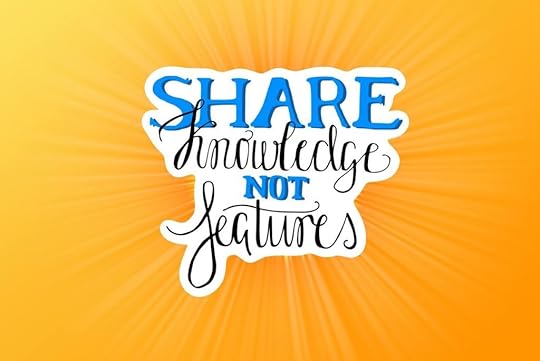Adam DuVander's Blog
July 27, 2025
I still like maps, baseball, and writing
Life moves fast, but not necessarily on a personal blog. A lot has happened in the two years between posts. But this will focus on three things that have stayed the same: maps, baseball, and writing.
It’s been 20 years since the Google Maps API was released and I’ve been excited about it since Day One. A map is still the best way to communicate location-based information. For example, if you were a baseball fan, you might notice two old-timers named Dutch Leonard. And neither one is from Holland.
That’s when you make a map of the birthplaces of all baseball players named “Dutch” (embedded above, thanks to my friends at BatchGeo). You can see, quickly and visually, that most of the 23 Dutches in baseball history are from the United States. Only two are even from Europe, and they’re both German.
As this map shows, I’ve rekindled my baseball fandom in the last few years. Among the instigators is a daily trivia game called Immaculate Grid and a couple trips to Oracle Park in San Francisco to see my Giants play.
 These great last-minute seats in 2024 may have helped
These great last-minute seats in 2024 may have helpedMost mornings I walk the neighborhood loop, come home to make some coffee, and consider the six teams or stats in The Grid. If I need a Gold Glove winner who also played at least one game at 1B, I’ll shy away from obvious choices like Keith Hernandez or even famous Giant Will Clark. Instead, I’d choose someone like Carlos Beltran, a great centerfielder who was once forced to play an inning at first.
Trivia is often trivial.
Another part of my daily routine involves writing. Sure, I write a lot in my work at EveryDeveloper, but I also started a personal project that gives me daily practice.
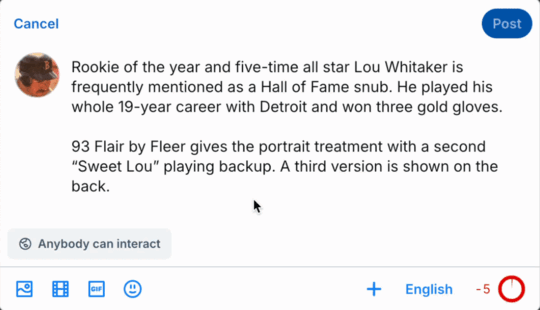
Starting January 1, I’ve posted a picture of one of my old baseball cards every day. To make it even more fun for a professional writer and editor, I make each description exactly 300 characters.
I called the account “Junk Card Boggs” (also on Insta) after Hall of Famer Wade Boggs and the concept that most of the cards that I own were produced in such quantities that they’re essentially worthless.
The exercise itself is anything but worthless. It keeps my skills sharp and provides a little brain teaser puzzle each day. Plus, it’s another way to connect to baseball, and gives me an excuse to look through my cards from time to time.
Most days I switch gears to more professional writing, which sometimes even includes map and location-related topics. Sometimes I manage to get my baseball fandom into work, as well, like when I shared how my encounter with a former pitcher could help marketers better understand developers.
February 27, 2023
Just 1% of My ProgrammableWeb Posts
A couple of minutes after noon on February 27, 2009, I was sitting at the counter of Motore Coffee in Seattle. I was two months into writing my first book. The topic, mapping APIs, got me an introduction to John Musser, founder of ProgrammableWeb.
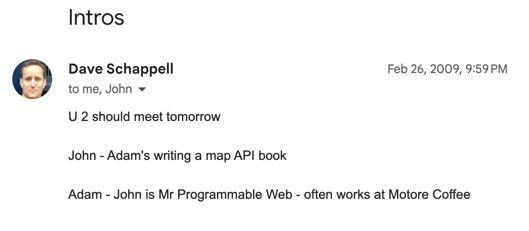
Less than a month later, John published my first post on his site. The first of 837 articles I eventually wrote following the rise of APIs. The meeting and my work at ProgrammableWeb was a turning point in my career, which now has me working with companies to better engage their technical audiences with content.
Earlier this month, the current owner of ProgrammableWeb redirected all of the traffic to a page that explains it’s been shut down. With the help of the Internet Archive’s Wayback Machine, I went back to find some of my impactful posts, at least to me. In this post, I’ll share nine of those 837—a little over 1%, for those keeping track.
Rubbing Elbows with Siri and Popular AppsBefore Siri was the household name of Apple’s built-in voice assistant, it was an app. Thanks to connections I made at Wired and ProgrammableWeb’s stature as the API place, I got to use Siri under embargo.
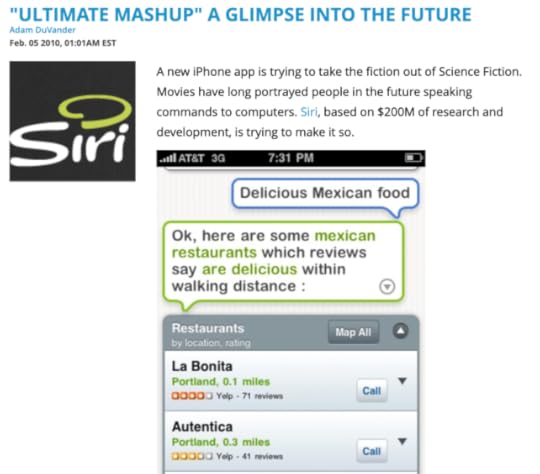
The founders called it the “ultimate mashup” and walked me through all the APIs it used. Reading through my Siri coverage, it’s fun to see what came true with voice assistants and the distance they still have to go—the bit about making transactions sticks out to me.
The Siri news might have been my first ProgrammableWeb news embargo, where I had to keep quiet until a specific time we were allowed to publish. With several days heads up, I even created a video walkthrough. I swear the text on the screen was readable originally!
Another popular app with an API angle came later that year.
Instagram surged in usage in late fall 2010. Everyone was excited about the experience on their phones, but there was no other way to connect to your photo stream. There wasn’t even a web view at that point, meaning you couldn’t share outside the app.
It was limiting… and as they often do, a developer decided to build anyway.

Using a proxy, the dev reverse-engineered the private API used by Instagram’s app. Then he hosted documentation and a Ruby library on GitHub as a public service for other devs that wanted to build on Instagram.
I’m pretty sure this was a scoop, one I found from reading tweets about APIs. No other publications were picking up stories like this at that time. It meant I got to trade emails with Instagram co-founder Kevin Systrom as I covered the story in follow-up posts. For several months, ProgrammableWeb owned the search results for “Instagram API.”
The biggest single day of traffic came from a post that took me seven or eight minutes to write. I was searching through Twitter again, reading every single tweet with “API” in it—that was possible at the time. My goal was to write a “Today in APIs” roundup of news, but one tweet jumped out to me as worthy of its own post:

Backend-as-a-service company Parse encouraged engineers to “apply via API,” sending their information in JSON rather than through a form or email. It was novel, it was fun, and the post instantly got attention.
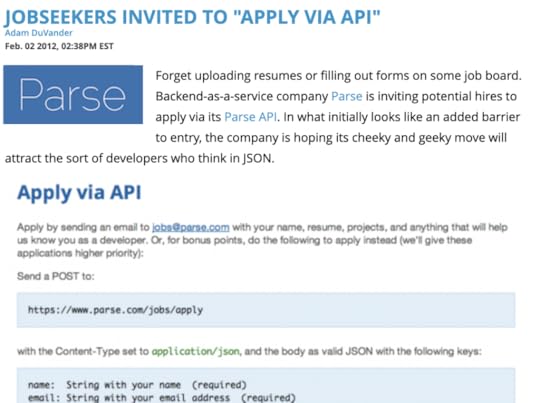
A week later, Parse co-founder James Yu told me, “I felt like every mobile developer in the valley was probably talking about Parse that night.” A year later, Parse was part of Facebook. So was Instagram. The other popular app, Siri, was of course purchased and incorporated into Apple’s operating system.
Were these three successful because of their ProgrammableWeb coverage? Maybe so. 
It was fun to cover big news, creative apps, and other API-related topics. Even after joining full-time in 2010, it took some time for me to appreciate the directory side of the business. Looking back, the biggest opportunities at impactful, creative work were when I combined the news and the directory.
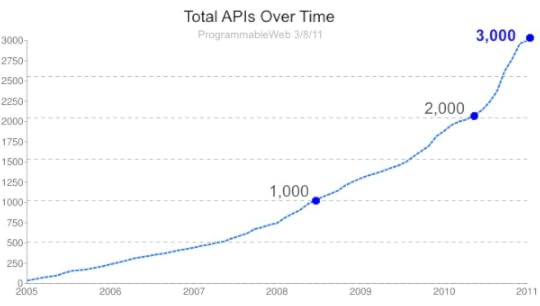
The first time I really dug into the data was when ProgrammableWeb approached 3,000 APIs. At the time it seemed like a huge number. Before the site shut down, there were more than 20,000 tracked. My 3,000 APIs post calls out API as a company, JSON, and internal usage as trends.
For years afterward, I’d see that hockey stick API growth chart in dozens of presentations at conferences. Several people told me they included it in fundraising decks.

It’s admittedly pretty nerdy, but I also really liked tracking the data formats supported by APIs. Again, this was data nobody else had, especially when you consider the value of historical data. We could look at formats by year, by API category, and any sort of combination we wanted to pull from the database.
I’m pretty sure the “bye XML” post was a collaboration with John after one of his talks. Everyone loved learning from directory insights and I wanted it to go beyond the few hundred people in the audience. Being the first audience for John’s analysis was also fun and taught me a lot about finding stories within trends.
Though I did a lot of trend-chasing at ProgrammableWeb, I also got to take on topics just because they were fun for me.
Following the Fun and Interesting StoriesBeing editor of ProgrammableWeb meant I saw all sorts of news cross my desk each week. Most we couldn’t cover, a few topics got picked up by our freelancers, and I chose to follow a handful on my own. Before I joined full-time, I assume John did a lot of this filtering on his own. One of my favorites came early into my time as lead writer.
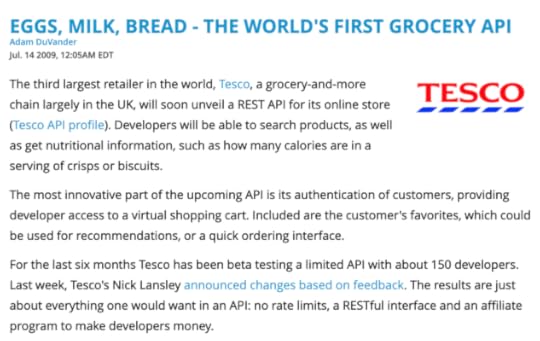
Firstly, it’s a pretty good headline. Mostly I love this post for the future possibilities it sees for APIs. It had access to store inventory, safe authentication to a customer’s cart, and even a way to make developers money. A grocery API was notable in 2009 and it seemed like a glimpse of what would be normal in just a few short years.
Possibility was also in the air the next year at SXSW. I was already attending, but the ProgrammableWeb connection also got me a press pass. I took my coverage seriously and spent a significant time under the Circus Mashimus tent.
Mashery had representatives from several of their customers in one room. In particular, the Best Buy DVD mashup sticks out: the company flew a developer out to talk about what he built with its API. This was precisely the ProgrammableWeb audience at the time, so I excitedly asked him to tell me his story, which I captured on video.
If I could have told stories like that every day, I would have. That developer excitement got me excited.
In fact, my very first post on ProgrammableWeb was about sharing something fun a local Portland developer created:
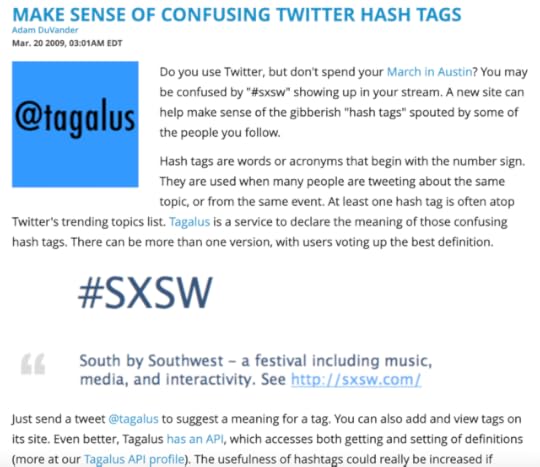
Twitter had become big just two years earlier at SXSW, so I used that example for a hashtag service I’d likely seen covered by Silicon Florist. “Tagalus,” now long gone, crowdsourced definitions of hashtags, still a fairly new concept. Not only did Tagalus use the Twitter API, but it also had its own API, making it a no-brainer topic for ProgrammableWeb.
The End: Part IJust a few years later, I’d written 800-ish posts and ProgrammableWeb was searching for a buyer. I was ready for a change and was uncertain whether the publication could maintain its unbiased approach under an API management vendor.
I supported—and then reported—the Mulesoft acquisition, but did not join as an employee. I stayed on as a Contributing Editor for a year and wrote some great analyses with the agreement of my new employer, SendGrid.
Mulesoft’s stewardship of ProgrammableWeb was a pleasant surprise and it lasted a good long while. I’m obviously sorry to see the industry resource go and, personally, I no longer have an archive of my stories from that time.
Here are the nine mentioned in this post, in chronological order:
Make Sense Of Confusing Twitter Hash TagsEggs, Milk, Bread – The World’s First Grocery API“Ultimate Mashup” A Glimpse Into The FutureDVD Collector Remixes Best Buy API to Share CompilationThe Full-Featured, Unpublished Instagram API3,000 Web APIs: Trends From A Quickly Growing Directory1 In 5 APIs Say “Bye XML”Jobseekers Invited To “Apply Via API”ProgrammableWeb Joins MuleSoftAnd 828 others on the archive of my profile page.
March 5, 2022
A Simple Personal Portal
Recently I pushed a new, streamlined version of my personal website. Not this one, which bears my name, but the shorter, dot-org-ier version of the username I choose if I’m early enough—which, these days, I’m usually not.
Part of me was looking for a tiny creative project. But it was important that it be pretty darn small, as I was just looking to get something together in the margins of the weekend.
What’s a simple website look like in 2022? I couldn’t get the retro constraints of 8 bit out of my mind, so I ended up with this:

My “web designer” days are far behind me so I went looking for an existing theme. Instead, I found some nostalgic CSS styles. It didn’t include layout and using a framework for a tiny page seemed overkill. So, I went retro here, too: I swiped HTML from the demo page with some old-fashioned View Source.
Somewhere along the line, I bumped into a blog post by the creator of these NES.css styles. Their primary motivation was kismet:
I like simple
That was my email signature for a long time and certainly behind the naming of Simplicity Rules®.
Why adamd.org Needed a ChangeIn fact, it was an email signature that sent me off to cobble together this new, 8 bit personal portal. Most of my online profiles now point to my business site. Recently, in an effort to get “business conversations” in the right inbox, I switched out to a more personal signature for personal email… which led me to visit adamd.org.
Its small digital footprint was crumbling:
An embedded video was brokenIt used an old business logoMy “professional timeline” stopped in 2018There was no mention of my latest bookWorse yet, there was a section titled “What I actually do” that went on to not describe very well what I actually do now.
Oops.
Rather than replace every section of the old site, I used the two simplicity paths to arrive at the core of what’s needed today. I’m calling the new site a personal portal because it mostly points out to other places to find me on the web. It;s there as a snapshot of my most important projects right now.
As a writer, I think in word counts. The new site only includes 126 words. If I had more time, I might try to cut that down some more, as I’m sure Mark Twain would have written on his website.
And… What Else is New?One of the projects on this new personal portal really deserved its own post here. Alas, at this point I’ve buried the lede…
I wrote another book!
Published in May 2021, Developer Marketing Does Not Exist shares the philosophy behind my work. More importantly, it’s helped over 1,000 marketers reach more of the right developers. It was covered by Nordic APIs and Techcrunch.
A book a decade, I joked. Map Scripting 101, now out of print unless you count the five copies I still have, was published in August 2010. It received much more “coverage” on this here site.
Even by 2010 things on the web had changed. Social networks became the way we shared the latest. Blogs, which started as personal endeavors, became businesses… and businesses added blogs.
In 2007, I lamented that the personal website had disappeared. The hand-crafted, HTML playgrounds became templatized and themed. And I wrote those laments on a blog that was sterile by comparison.
Forgetting to note new achievements like books, jobs, and—I dunno—children is one sign of how both adamd.org and adamduvander.com haven’t kept up with changes. That may remain the case, but at least for now, both have some version of my latest news.
Simply put, that’s good enough for now.
It’s Been 668 Days
This is one of those classic personal blog posts.
Here’s the structure:
I point out how long it’s been since my last postI apologize for the inconvenience to youI promise to do better in the futureI’m going to buck the trend and only do #1.
It’s Not an Abberation, It’s a PatternYes, there have been 668 days since my last post, which was kind of a joke about the glue of the internet. Those 668 days, for those who are keeping track of such things, set a record. This current gap, which ends today with this post, surpassed the previous record by 181 days.
The last record was set in 2016 and its gap stretched back into 2015. I have been not writing on this blog for a long time.
Look, I made a chart:
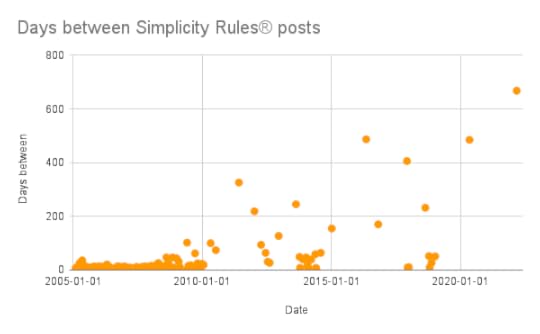
Those first five years were prolific, but I explained that in a different chart in a post from 2015. I blamed it on the cobbler problem since writing blog posts has been some part of my professional capacity for years now.
The days between posts have expanded. In the last five years, I have written here 11 times. On average, that’s 178 days between posts. That’s about two posts a year, which is more than I would have guessed.
But things are about to get crazy.
Bursts Used to Be the NormI might not be sticking to the structure of the first-post-in-awhile post, but I am keeping the spirit intact. There’s already been one self-referential chart. Another is on the way.
During some time when I could have written a meaningful post, I reviewed the data for my personal blog. Something about the days between posts numbers jumped out at me: not only did I blog more frequently at one point, but I also used to publish multiple posts on the same day.
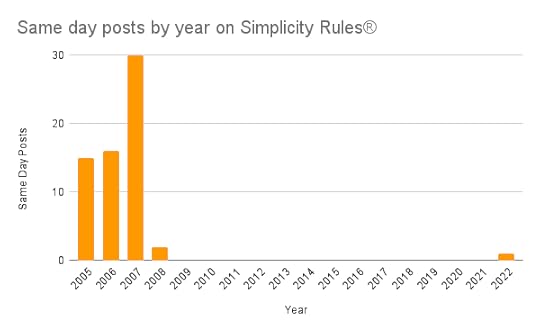
There were 61 days from 2005 to 2007 that I wrote two posts. The next year, it happened twice.
And then: a long, long drought. More than a decade.
Those with a keen eye for chart-reading will notice there were multiple posts published on the same day in 2022. Since this post broke a streak of almost two years between posts, it seems impossible.
Your omniscient narrator knows something you don’t.
I’m Not Sorry and I’m Not ChangingI’d originally planned a different post to share some news and poke fun at the plight of personal websites. But curiosity about the time between posts got the best of me and next thing you know, I’d made charts.
So, now I’ve gone to great lengths to point out how long it’s been since my last post.
But I haven’t apologized for the inconvenience to you. And I won’t. Because I hope you haven’t been reloading this page for 668 days.
I also haven’t promised to do better in the future. In fact, I showed data that suggests I’m more likely to do worse in the future.
Now…
Remember that different post I was going to share before I got distracted by this meta-post? The reason I’m confident enough to include same-day data in 2022 is I’ve already written that post. Through the magic of editing, I’ll include a link to it here once I’ve published it.
But please remember: just because I’ve published twice in one day for the first time since April 22, 2008, does not mean I’ve promised to do better in the future. And I’m not sorry about that.
May 6, 2020
The Glue of the Internet
Have you heard about the glue of the Internet? It is many things. I am the glue of the Internet. You are the glue of the Internet.
IF PHP IS THE GLUE OF THE INTERNET THEN FACEBOOK HAVE BEEN SNIFFING IT PRETTY HARD LATELY HA
— PHP CEO (@PHP_CEO) March 25, 2014
I do have a history of noticing cliches. So, when I came upon this one again, I had to etch it in stone for eternity right here on this blog.
Those Sticky, Sticky APIs
I’ve written about APIs for over a decade, so before publishing a post like this, I had to confirm I’ve never called them the glue of the Internet. Google says I haven’t.
I have spoken at GlueCon, a fantastic developer conference that is in its 11th year. If I had to guess, its name is slightly tongue-in-cheek, which shows how long this has been a cliche.
APIs are the glue of the Internet, said Spanish multinational bank BBVA in 2016. More recently, Open Banking initiatives have hammered home its gluey status, as American Banker declared in 2019.
Software testers are often working with black boxes. So, let’s hope the glue dries clear when they’re testing APIs. Because APIs are the glue of the Internet.
They’re also the glue of many other things. APIs have a lot they’re holding together!
That’s a Hard iPaaS
Truth be told, this post was inspired by Integromat, an integration platform-as-a-service (iPaaS). I’ll just leave a screenshot of its home page here:
 Integromat is the glue of the Internet?
Integromat is the glue of the Internet?For two years, I worked at Zapier, a competitor that predates Integromat. I may be biased, but I found plenty of examples (this being the oldest) declaring that Zapier is the glue of the Internet.
On the other hand, Zeleo invites you to glue the Internet together.
And, to be fair, TechCrunch declared IFTTT to be the Internet Glue Service in 2014.
The Elmer’s of Protocols
APIs and iPaaS are nothing compared to the series of tubes the Internet is built upon.
BGP is the glue of the Internet, according to a 2012 Cloudflare post recapping Google downtime. Border Gateway Protocol, as it’s known formally, determines Internet routes.
Indeed, network interconnection points are the glue of the Internet, as declared over 20 years ago in an article that also mentions long distance phone services and dial-up Internet.
A little farther up the stack, you bet that HTTP is the glue of the Internet. Or is TCP/IP the glue of the Internet? Or maybe Sendmail and FTP?
Keeping up the Paste
There are so many other things that may be the glue of the Internet, it’s really hard to keep track.
Dan Gilmour said that links are the glue of the Internet. But Rhett Allain said link aggregators are the glue of the Internet. Why not both?
Speaking of memes, another site claimed that memes are the glue of the Internet. I’m not linking the site because it also wanted me to download Flash and then forwarded me to an advertiser’s site before I could cancel it.
But I appreciate the sentiment: with Internet as the glue of our everyday lives, the glue of the Internet should move beyond the technical bits. It’s not just APIs, protocols, and integration tools.
It’s the sorts of stuff that everybody can appreciate. If it’s not memes, maybe photobombs are the glue of the Internet?
Let me know what’s gluing your Internet together.

January 7, 2019
The Possibility and Pressure of a Blank Slate
10 years ago I stared at an empty OpenOffice document. The cursor blinked expectantly.
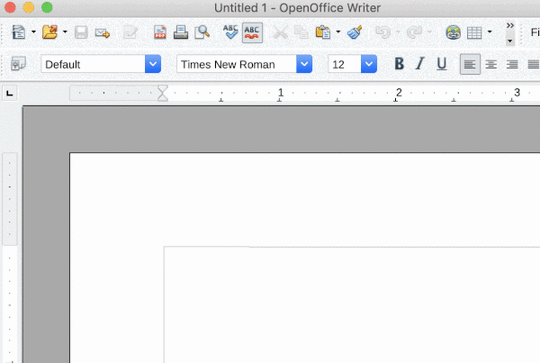
It was early January, 2009, I had inked a book deal, and was frozen. My proposal included a complete outline, so it’s not like I didn’t know what to write.
There’s some comfort in an empty document, the italicized Untitled filename can still become anything. With a blank slate, there is only possibility.
I rationalized that maybe I shouldn’t start with chapter one. It’s like a persuasive essay where you write the introduction last so you can foreshadow the argument you’ve already made. That makes a lot less sense for a programming cookbook, but I moved on to chapter two.
It didn’t get easier. All I could think about was how permanent the words would be, printed into 5,000 copies. Nevermind that it would be 18 months later and that I’d have at least five opportunities to change every word, sentence, and code sample.
I felt the pressure of the possibility.
Possibilities are Endless with a Blank Slate
Fresh starts are nice. Despite the pressures of writer’s block, the truth was the blinking cursor was all possibility. As I write this, it’s the first week of 2019. A new year. Resolutions abound as people optimistically look out at the possibility of a blank slate.
There is potential energy stored up in anything new: freshly fallen snow, a beautiful wedding cake, or electronics straight from their packaging, that static plastic film still covering the screen. Unfortunately, none of those things fulfill their purpose left in their pristine state. The electronics should be used, the wedding cake should be cut (and eaten!) and that snow should be trod upon by hefty winter boots.
Most new things are concepts rather than physical things. Semesters in school—then quarters in business—each bring new possibilities. Monday is the start of a new week and every single day (so far) the sun rises. Even a washed car and full tank of gas hold inspiring potential.
You don’t need to wait for some milestone (like January 1), you can make your own newness. My friend Mike Vardy advocates starting the new year whenever you want. Because of his influence, I’m 12 weeks into training for a 5K rather than starting with the calendar year.
Making newness means you’re manufacturing possibility. That feels great, but comes with the responsibility of moving toward that potential. For me, that responsibility means I’m also manufacturing pressure, the same sort that had me staring at the blinking cursor 10 years ago.
Pressures Increase when the Slate Remains Blank
Here’s where the internal dialogue starts: I’ve written the section above, but this one is empty. That’s a lot of pressure. I’m happy with this post so far. What if I screw it up? But if I never write anything, the post will never be finished.
Some people spend years in the state of possibility. It’s like the old calculation of an idea’s value. The execution is what’s valuable and the idea is a multiplier. The idea is the possibility, and it’s much more comfortable than taking action. When you execute, you might find it’s harder than you thought, and you might feel the pressure of a reality mismatched with the fiction of possibility.
It was almost three years ago that I decided I should be a runner. I knew there were programs that started slowly with a mix of running and walking. Putting shoes to pavement is the ultimate reality check. It was much easier to imagine having done it than to do it. Two years passed. On my birthday in 2018, I created an event page for the following year, but never published it. Finally, six months later, I laced up my shoes and ran a couple blocks.
When you start turning the possibility into reality, the pressure should decrease. The build up of potential energy is translated into action. At the same time, and this can be hard, the possibility also decreases. This thing you’re doing is becoming real. It may not match what you imagined. But your working on it is the only thing that fulfills its potential.
For me, after awhile of taking action on the newness, once it stops feeling new, another blank slate appears in my mind. It’s the one that imagines that others will really love it or really hate it. It’s a cycle and it includes new possibilities, which means new pressures. And the only way around that is more action: launching, sharing, or whatever it is that will move that reaction from possibility to reality.
Will You Ever Write Another Book?
This post started as a way to commemorate the 10 year anniversary of a huge project about which I’m proud. Even if technology, as it inevitably would, has made my book a bit outdated, I can always say I wrote the book on map scripting (primarily because that’s a term I made up!).
When that 18 month process came to a close with the book’s publication in 2010, I was often asked whether I’d write another book. At the time I expressed uncertainty. There’s a lot to gain from writing one book (it’s the reason for my current career path), but the jump to two-time author is seemingly less impactful.
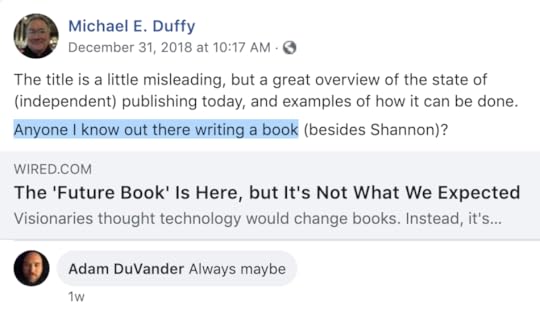
It’s been awhile since someone asked me, but my ol’ blog buddy Mike Duffy posted on Facebook and I found myself responding: “Always maybe.”
If I wrote another book, I’d definitely remember what I learned last time: write it in the margins of work and focus on progress every day. But I’d also look to share more sooner, to tighten that possibility and pressure cycle.
Recently I came across Kelly Miller’s 30 day book project. From October 1 to November 1, Kelly moved the project forward, from outlining, to writing, to editing. And she has an epic Twitter thread where she checked in every day with progress.
Regardless of whether it’s writing a book, I think we can all learn from that approach to the projects that matter to us. As the possibility turns to pressure, remember that forward progress both relieves the pressure and brings your efforts into reality.

November 17, 2018
How the Best Developer-Focused Companies Reach Their Audience
I’d start this post by proudly making an announcement, but that sort of sentence serves the writer more than the reader. You’re here to learn how developer-focused companies reach their audience. I’ve been exploring developer communications for a long time, going back to my time writing code. I’ll be applying what I’ve learned in my new consultancy and no doubt learning plenty more, too.
Developer marketing—if you must call it that—is more about education than selling. It’s about discovering, feeling, and solving a developer’s problems. You’re a guide inspiring them to see what’s possible.
Understand Your Developers
When you look at the best developer-focused companies, like Twilio and Stripe, there’s a natural developer flavor that comes across. While they start with great products, the communications effort comes down to understanding their audience.
Far too many attempts at developer marketing start with a focus on the product. That’s part of the equation, but too often that’s where it ends. If you’re only thinking about the what, you miss out on the real value in the why and the how.
You need to really understand what sort of problems your API or developer tool solves. If you’re a developer, you may be able to spitball your way to some ideas. If you aren’t a developer, you likely talk to more technical teammates, but the value could be lost in translation.
The absolute best way to understand your developers is to talk to them. That assumes you know who your developers are. If you don’t know that, there’s even more work to do. Start by talking to who you think your developers are and see what resonates. Developers are typically forthright with their feedback.
Figure out what the pains, frustrations, hopes, and desires your developers hold. Keep a log. It won’t take you very many conversations to get a good feel for where you can help. Though I’ve done some version of this in most of my roles, my time at Zapier is freshest in my mind. I jumped on many calls with users building on the platform and saw those insights enter into my writing, as well as product decisions.
Show Developers What’s Possible
Once you understand your developers, communicating becomes much easier. You can focus on the developer, not the product. Or, put another way I’ve espoused the last five years, share knowledge, not features.
This is where developer education and inspiration comes in. Developers are curious. What can you teach them? You already know their pains, so start helping them. At Orchestrate, we knew our best developers were starting something. So, we showed them how to add user login to their app. It turns out, you need a database to hold user accounts, and that’s what Orchestrate provided. That single tutorial drove thousands of visits over the years.
Simply cross-referencing developer pains with a couple of languages or frameworks can give you plenty of roadmap for months worth of developer content.
And that’s really what the best dev-focused companies do to reach their audience. They speak directly to how developers can solve their problems. And while they may attend events and otherwise reach some developers in person, the real scale comes from content: blog posts, guides, documentation, and more.
API and Developer Expert for Hire
For the last 10 years, my professional focus has been engaging with developers: from writing tutorials at Wired—or writing an entire book—to working at API companies like SendGrid and Orchestrate. With each new role I learned more about developer audiences, how companies reach them, and the type of work I do best.
Not everyone is able to execute themselves on what seems like a simple two step process. First, understand your developers. Second, show them what’s possible.
I’ll be walking the talk on EveryDeveloper and helping the best dev-focused companies reach more developers.

October 21, 2018
How to Make a Decision by Switching Perspective
When I was young I had trouble deciding what gift to buy for a friend’s birthday. Truth is, I had trouble with a lot of decisions then. Though I’ve become better at it, I’d say it’s still a struggle. Perhaps the birthday conundrum stays with me because my mom had great advice that somehow simplified it for me.
Mom’s approach, as I stood indecisive in the toy aisle, was for me to choose the gift that I would like to receive. I could simply pretend to pick a gift for myself, then give it to my friend. This mental shift saved me from the paralysis of wondering what my friend might like. And since it wasn’t really for me, I didn’t have to worry about regretting my choice, either.
 Photo by Jay Malone
Photo by Jay MaloneI can report this trick doesn’t work as well for gifts into adulthood. I could buy myself most any business book off the shelf, for example. That’s less likely to appeal to my wife. While we can’t use mom’s exact advice, a reverse approach can help anyone make decisions.
Give Advice to a Friend, Then Take the Advice Yourself
If you’re struggling with a choice, simply imagine the advice you’d give a friend in a similar situation. The book Decisive calls this “attaining distance.” You might not think you’re capable of tricking yourself this way, but many people do give others advice they wouldn’t give themselves. In one example from the book, people are given two choices:
An uncertain path with the possibility of long-term happiness
A safer choice of the status quo
When deciding between the two for themselves, 66% select that first path of potential happiness. When advising others, 83% of people suggest the first path.
There’s a famous story, also retold in Decisive, about how Intel switched its business to microprocessors (how they’re best known today). The change had an uncertain path, but included a possibility of long term happiness (i.e., success for the business). Their historical market was in memory and was a safer choice only because they were the leader.
Intel’s exec’s were having a hard time deciding between those paths when one asked the other: “if we were fired, what would the new team do?”
By pretending to advise someone else, it was clear the answer was to take the risk on microprocessors.
My Favorite Interview Question is About Weaknesses
The answer to the classic weakness question in job interviews is painfully predictable:
“I work too hard, I care too much, and sometimes I can intimidate my co-workers by being too good at my job.”
Asking someone their weaknesses requires them to not only be self-aware, but also honest. That’s a lot to ask in a scenario where everyone is trying to show their most positive attributes.
The book Who suggests a reframing of the question. While discussing a previous supervisor, you ask “if I talked to them, what would they say are your biggest strengths and areas for improvement?”
We used this question when I worked at Orchestrate and it was amazing how much better the answers you get with this change in perspective. Sometimes people were maybe even a little too honest. It’s much harder to give the weakness-that’s-a-strength reply when you’re answering on behalf of another person, especially someone who the interviewer might talk to if they check references.
Be Objective, Make Better Decisions
Whether you’re struggling with a personal choice or making a hire for your company, objectivity is your friend. It’s hard to be truly objective and even harder to force that on a candidate. You can frame questions–to yourself and others–in a way to nudge the answerer to flip their perspective. How would someone else answer this question? How would you answer this question for someone else?

October 11, 2018
Momentum: a Simple Motivation Trick
Your favorite baseball team is down by three runs in the bottom of the ninth inning. This is rough anytime, but during the playoffs, this can be demoralizing.
What luck! The leadoff batter squeaks a hit through the infielders. The next guy singles into right field and there are runners on the corners. Your team is still down three runs, but any fan will tell you it’s different now.
Momentum has swung in the direction of your team. Now they aren’t working to avoid a loss, they’re constructing a victory.
You don’t have to be a baseball player, or even a baseball fan, to get this kind of momentum. You can create it.
Working out: Every Day or No Way
Two years ago I was having a hard time getting to my three hourly visits to the gym each week. I tried the usual trick of putting it on my calendar. But it required a 90 minute block, which often meant it got shoved aside due to urgent work. Mike Vardy at Productivityist recommended a 30 minute workout five days a week, but making time every day seemed even harder.
A year ago I finally took Mike’s advice and it’s made all the difference. I don’t need to think about whether it’s a workout day, because every workday is a workout day. And I can more easily fit a shorter workout into my day. It’s an hour round trip. And once I’ve gone a couple days in a row… I’d miss it if I didn’t go the next day.
Among the things I do at the gym is this funny-looking exercise called a kettlebell swing. It’s a little awkward the first few times, but it’s all about momentum. You drive the kettlebell back between your legs. As the pendulum moves forward, you stand and drive your hips forward. When the kettlebell falls backward again, repeat.
Once you have it down, momentum carries you through. If I get stuck, I can start again. It requires a little extra effort, but I know from experience that the motion of the exercise will create the movement on its own.
Consistently starting allows me to see progress, whether it’s another set of kettlebell swings, a new week at the gym, or any project I want to see be successful.
Fundraising: Show the Movement
How many times have we seen a friend share their fundraiser, only to see nearly $0 raised? Be honest: how much does that make you want to donate?

Some people might want to provide that first donation to help, but the majority will not be motivated. This is something professional fundraisers know. They’ll quietly gather donations from insiders before publicly acknowledging progress.
There’s a good chance you’ve never seen an empty “fundraising thermometer” in official materials from a sophisticated non-profit. Wired Impact’s best practices for encouraging donations with social proof specifically makes this point:
It’s nice to create a sense of progress before you launch the fundraising thermometer. An empty fundraising thermometer can hurt you more than it helps you. When it comes to donations, people don’t want to think that they’re the first. They want to see that lots of other people have trusted your nonprofit with their hard-earned dollars.
People want to support forward progress. The same thing that works with someone else’s fundraiser can also help with your own projects.
Blogging: Plan What You Publish
Though my personal blogging has been spotty, I’ve been doing it professionally for more than 10 years now. Many times I’ve been the one who created a publication plan, laid out an editorial calendar, and worked with writers (including myself) to execute.
Every time there is effort needed to start, but consistency creates momentum. It doesn’t take more than two or three weeks of publishing for it to take on a life of its own. Ideas get easier to come up with, posts become easier to write. It’s like the baseball team that gets a couple hits and suddenly feels in the game again.

When I speak at conferences or do trainings on technical content strategy, I always recommend an editorial calendar, but stress that the tool you choose doesn’t matter. What you need is a way to plan your posts in advance, so everyone on the team knows what’s coming.
Importantly, your plan for upcoming content has to look like a real headline, not some placeholder gunk. I think one of the reasons this works so well is that it helps you start at the ending.
It marks out the future as if it’s already happened, which means you can already feel the momentum.
Overwhelm: Overcome it With Action
All of this sounds great to someone with the motivation to start. We all get overwhelmed, which makes it much harder to take advantage of the simple trick of momentum. Alex Theis has a short, impactful episode of his podcast for exactly this situation.
There’s not really a replacement for taking action, but Alex shares some ideas for getting unstuck. Things like making a list of everything you need to do, because knowing the full story is always better. Then choose the things that are most nagging you and do those. Again, you’ll feel the momentum.
Alex tells a story of how he turned overwhelm into one of his most productive days. You can do the same by using momentum positively. As you write the blog posts, go to the gym, or make your ninth inning comeback, look for the ways you can see the momentum.

August 20, 2018
Does Anyone Read Your Email Signature?
If you spend as much time in email as I do, you’ve probably seen many email signatures. These bits of text (and sometimes images) are automatically added to the bottom of every email to identify the sender. Often, the signature is also used to promote the person’s company or latest projects.
For at least the last two years, my signature has looked like this:
Find me: adamd.org – @adamd – adam.coffee
Though instead of direct links, I used Bitly to track the clicks. That was because I wondered whether anyone actually read and followed the content in my signature.
Well, over the years I’ve learned that people definitely notice the signature. One element of it specifically has received attention in replies, as well as in person.
People Love adam.coffee
Though I try really hard not to buy domains I never use, I lined up on opening day of availability of the .coffee domain extension to grab adam.coffee. At around $30 a year, it felt like I should use the domain rather than just sit on it (sadly, over 60% of .coffee domains are parked, meaning they aren’t being used). I’m not enough of a coffee snob to review coffees or perform tastings. Without any more creative ideas, I simply hooked it up to my calendar and let people book time wth me on certain days.
Frequently, I’ll get replies like this to emails:
"I want to sign up for coffee with Adam! I just followed the adam.coffee link and that’s cool.”
"I’ll use your coffee link (which is brilliant btw
Adam DuVander's Blog
- Adam DuVander's profile
- 4 followers


